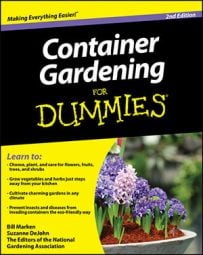When you water a container plant, the goal is to moisten the entire root ball and apply just enough water so that some drains out the bottom. Now, if the container is properly planted, a space exists between the top of the soil and the container’s rim that you can fill with water. It may be anywhere from 1 inch in small containers to 4 or 5 inches in larger ones. But whatever the case, you have to fill it more than once to get enough water to wet the root ball. That means filling the pot once, letting the water soak in, and then repeating the process until the whole root ball is moist.
This whole soaking process is a bit tricky for one reason. As the root ball in a container dries, it shrinks, usually pulling away from the edges of the pot. So when you water the first time, the water drains down the edges without reaching the root ball at all. This phenomenon explains why you need to make several passes with the hose or watering can — so that the root ball swells up a bit and seals the edges of the container, at which point the water can soak in. This is also why you can never judge how wet a root ball is by the amount of water that comes out the drainage hole. You may be fooled every time. Check water penetration by lifting the edge of the pot or poking in a finger.
The fact that drainage holes may fool you doesn’t mean you should do away with them. Without them, the plant drowns. Periodically check the drainage when you water. Even if your containers have holes in the bottom, they may fill up with roots, preventing proper drainage. Cut the holes open with a knife if necessary.
You can wet shrunken root balls or plants that are really root-bound in a few other ways:
Water from the bottom: If you place small trays or saucers underneath your pots to catch excess water, that water is gradually reabsorbed by a dry root ball. You’re basically watering from the bottom, at a pace dictated by the plant.
It’s not a good idea to have a container sitting in water for a long time. The root ball becomes too wet and eventually the plant drowns. But submerging a pot partially, or even completely, for just a little while doesn’t hurt, and it’s a great way to wet a really dry root ball. In fact, if your plants get too dry, set them in a container filled with several inches of warm water — use the kitchen sink, a 5-gallon bucket, or your child’s swimming pool, whatever’s easiest. Let the pots bathe for an hour or so; then remove the plants and let the excess water drain off.
Use drip irrigation: Drip emitters apply water at a slow, steady rate and do a great job of thoroughly wetting the root ball.
Water plants deeply and thoroughly; then allow them to dry out a bit before watering again. Avoid frequent light sprinklings, which encourage roots to form near the soil surface where they’re prone to drying out. Deep but less frequent watering encourages healthy, deep roots.

